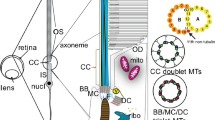Summary
The connecting cilium of rat retinal rods was studied by freeze-fracture and thin-sectioning techniques. Transverse strands of intramembranous particles could be observed on fracture face B of the ciliary plasma membrane. The strands were essentially similar to those found at the transitional zone of motile cilia (“ciliary necklace”). The large number of intramembranous particles obscured the pattern on fracture face A of the membrane.
On longitudinal sections of the cilia, beads showing a periodicity similar to the necklace strands were observed. Each bead consisted of two structures apposed to both sides of the plasma membrane. Transverse sections of the cilia revealed radial Y-shaped structures that connected each ciliary doublet with the plasma membrane. Axial tubules, central sheath, radial spokes and dynein arms were missing in the connecting cilium.
Comparing the fine structure of the retinal cilia with that of motile cilia it becomes evident that the connecting cilium is analogous in structure with the transitional zone of motile cilia. The present observations suggest that periodic membrane beads along the plasma membrane on thin sections correspond to strands of necklace particles as observed on freeze-fractured membranes. The arrangement of the particles in transverse strands is probably ensured by the radial connecting structures.
Similar content being viewed by others
References
Anderson, R.G.W.: Isolation of ciliated and unciliated basal bodies from the rabbit oviduct. J. Cell Biol. 60, 393–404 (1974)
Daemen, F.J.M.: Vertebrate rod outer segment membranes. Biochim. biophys. Acta (Amst.) 300, 255–288 (1973)
Flower, N.E.: Particles within membranes: a freeze-etch view. J. Cell Sci. 9, 435–441 (1971)
Futaesaku, Y., Mizuhira, V., Nakamura, H.: A new fixation method using tannic acid for electron microscopy and some observations of biological specimens. Proc. Int. Congr. Histochem. Cytochem. 4, 155 (1972)
Gilula, N.B., Satir, P.: The ciliary necklace. A ciliary membrane specialization. J. Cell Biol. 53, 494–509 (1972)
Heller, J.: Comparative study of a membrane protein. Characterization of bovine, rat and frog visual pigment s500 Biochemistry 8, 675–678 (1969)
Hong, K., Hubbell, W.L.: Preparation and properties of phospholipid bilayers containing rhodopsin. Proc. nat. Acad. Sci. (Wash.) 69, 2617–2621 (1972)
Jan, L.Y., Revel, J.P.: Ultrastructural localization of rhodopsin in the vertebrate retina. J. Cell Biol. 62, 257–273 (1974)
Mason, W.T., Fager, R.S., Abrahamson, E.W.: Structural response of vertebrate photoreceptor membranes to light. Nature (Lond.) 247, 188–191 (1974)
Matsusaka, T.: Membrane particles of the connecting cilium. J. Ultrastruct. Res. 48, 305–312 (1974)
Young, R.W.: Passage of newly formed protein through the connecting cilium of retinal rods in the frog. J. Ultrastruct. Res. 23, 462–473 (1968)
Young, R.W., Droz, B.: The renewal of protein in retinal rods and cones. J. Cell Biol. 39, 169–184 (1968)
Author information
Authors and Affiliations
Rights and permissions
About this article
Cite this article
Röhlich, P. The sensory cilium of retinal rods is analogous to the transitional zone of motile cilia. Cell Tissue Res. 161, 421–430 (1975). https://doi.org/10.1007/BF00220009
Received:
Issue Date:
DOI: https://doi.org/10.1007/BF00220009




